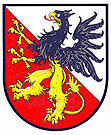Ploskovice
| Ploskovice | ||||
|---|---|---|---|---|
|
||||
| Basic data | ||||
| State : |
|
|||
| Region : | Ústecký kraj | |||
| District : | Litoměřice | |||
| Area : | 842.1465 ha | |||
| Geographic location : | 50 ° 33 ' N , 14 ° 12' E | |||
| Height: | 238 m nm | |||
| Residents : | 458 (Jan 1, 2019) | |||
| Postal code : | 411 42, 412 01 | |||
| License plate : | U | |||
| traffic | ||||
| Street: | Žitenice - Býčkovice | |||
| Railway connection: | Lovosice – Česká Lípa | |||
| structure | ||||
| Status: | local community | |||
| Districts: | 5 | |||
| administration | ||||
| Mayor : | Věra Petrů (as of 2007) | |||
| Address: | Ploskovice 2 411 42 Ploskovice |
|||
| Municipality number: | 565393 | |||
| Website : | www.ploskovice.cz | |||
Ploskovice (German Ploschkowitz ) is a municipality in the Czech Republic. It is located six kilometers northeast of Litoměřice in the Bohemian Central Mountains and belongs to the Okres Litoměřice .
geography
The village is located in the right Elbe part of the Bohemian Central Uplands on Ploskovický potok.
Neighboring towns are Těchobuzice in the north, Býčkovice in the east, Luční Mlýn and Velký Újezd in the southeast, Trnovany and Podviní in the southwest, Maškovice in the west and Ploskovický Dvůr and Myštice in the northwest.
history
First documented the place was in 1057 with the founding of the cathedral chapter St. Stefan in Litomerice (Litoměřice) by Spytihněv II. And was one of 14 the cathedral chapter humble villages. In 1188 the village belonged to the possessions of Hroznata , who left it to the Order of St. John . In Ploskovice there was a commander who existed until 1421 and was abandoned when the Hussite army marched under Jan Žižka . In the following years the abandoned commander was the hideout of the robber knight Jeschek . During the Hussite Wars , Emperor Sigismund enfeoffed Jakoubek z Vřesovic with Ploskovice in 1436 . His descendants, who called themselves Ploskovský, built the commander into a fortress . In 1496 the subjects revolted against their landlord Adam Ploskovský von Drahonitz and submitted to the knight Dalibor von Kozojedy , who was executed two years later in Prague. His fate while imprisoned in the Prague castle tower "Daliborka" was romanticized during the National Awakening and dealt with by Bedřich Smetana in the Dalibor opera .
In the years 1545 to 1575, the fortress was converted into a Renaissance castle. During the Thirty Years' War various troops set fire to the place. During this time, the noble Schlick family bought Ploskovice and the castle was rebuilt in 1650 under Countess Marie Sidonie Schlick. She got over-indebted and in 1663 Julius Heinrich von Sachsen-Lauenburg acquired the rule. In 1689 Anna Maria Franziska von Sachsen-Lauenburg became mistress of Ploskovice. She had a new summer residence built between 1720 and 1725, which became her seat during her separated marriage to Gian Gastone de 'Medici . In 1775 another peasant uprising broke out.
In 1805 the rule fell to the Wittelsbach Maximilian Joseph III. von Pfalz-Zweibrücken , who in 1806 had to cede his possessions in Bohemia to Archduke Ferdinand of Salzburg with the acceptance of the Bavarian royal dignity . In 1816 the old castle was torn down. In 1830 there were about 200 inhabitants in the village. The castle estate included a brewery, distillery, board saw, grinding mill and a grinding shop.
After the removal of patrimonial Ploschkowitz became an independent municipality in 1848. After his abdication as emperor, Ferdinand I was given the management of the Habsburg estates in Bohemia in 1849. Ferdinand, who resided in Reichstadt , chose Ploschkowitz as his summer residence and had the palace added one floor. 300 families were employed on the estate, including the associated villages, and around 500 seasonal workers were added in the hop harvest . In contrast to the neighboring towns, the Czech ethnic group formed the majority in Ploschkowitz. In 1898 Ploschkowitz received a railway connection with the start of operations on the North Bohemian Transversal Railway. In 1907 the village had 407 inhabitants. After Ferdinand's death, his inheritance fell to Emperor Franz Joseph I and in 1916 to Karl I.
After the collapse of the Austro-Hungarian monarchy and the proclamation of Czechoslovakia , the property of the Habsburgs was nationalized. During the First Republic, the castle was the seat of the Foreign Minister and then served as a district children's home. After the Munich Agreement of 1938, a National Political Educational Institution for the Reichsgau Sudetenland was set up in Ploschkowitz . After the Second World War, the German minority was expelled . Today the castle is a museum.
Local division
The municipality Ploskovice consists of the districts Maškovice ( Maschkowitz ), Ploskovice ( Ploschkowitz ), Starý Mlýnec ( Old Lenzel ), Těchobuzice ( Techobusitz ) and Vinné ( Winney ). Ploskovice to also include local documents Leopoldův Mlyn ( Leopoldsmühl ), Luční Mlyn ( Wiesenmuhle ) and Nový Mlýnec ( New Lenzel ).
The municipality is divided into the cadastral districts Maškovice, Ploskovice, Těchobuzice and Vinné.
Attractions
- Ploskovice Castle with Castle Park, built 1720–1725, the plans for this were previously attributed to Octavio Broggio , according to more recent findings the building was designed by Wenzel Spatschek together with Kilian Ignaz Dientzenhofer and implemented by the latter.



